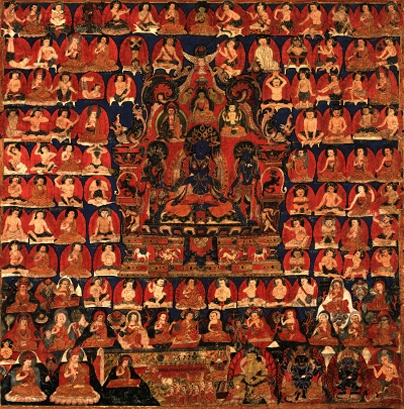
Mahasiddhas or the great tantric masters were true non-conformists of the Tantric Buddhist tradition. They resisted the comforts and strict supervision of Indian monastic living and instead practiced in impure, terrifying locations like cemeteries and cremation grounds. They displayed eccentric, even “crazy” behavior that flouted Buddhist and Indian conventions, consuming impure substances like meat and alcohol, violating rules of caste, performing violent rituals, and engaging in sexual practices forbidden to monks. Their behavior expressed the profound insight into the nature of reality, free of dualities and conventions. Despite living on the margins of society, mahasiddhas played a crucial role in the development of esoteric tantric practices that promise enlightenment in a single lifetime. Most Tibetan tantric lineages, even those that developed into powerful institutions, trace their origins to these Indian masters who lived outside of society.
This painting depicts 85 mahasiddhas surrounding the primordial buddha Vajradhara, who is considered the ultimate source of all tantric lineages. The mahasiddhas are depicted as individuals, each one assuming a distinct yogic posture and being accompanied by an identifying inscription. The names of the 85 mahasiddhas depicted here are standardized in Buddhist tradition, specifically the tradition of the Indian master Vajrasana. This painting defies linear order, with the mahasiddhas snaking around to the left and right. It originates from the ancient kingdom of Guge in western Tibet, a region that had many exchanges with northern India and its tantric traditions in the early second millennium.
Come view our Art of the Week in the exhibition Masterworks of Himalayan Art.
H 22 1/8 x W 22 in.
F1998.17.3 , HAR 665
- https://dev.rubinmuseum.org/images/content/2484/08.16.19_art_of_the_week_-_vajradhara__zoom.jpg
- https://dev.rubinmuseum.org/images/content/2484/08.16.19_art_of_the_week_-_vajradhara__zoom.jpg

